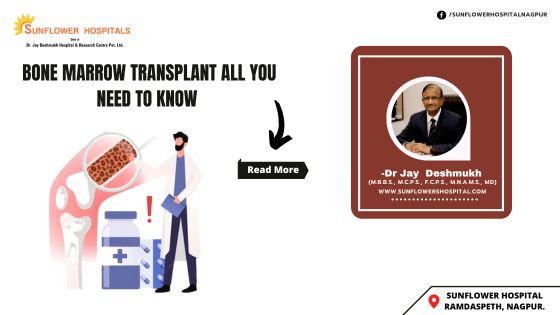What is bone marrow?
This is a soft, spongy tissue found inside bones. Most of the body’s blood cells develop and are stored in the bone marrow. The blood cells that make other cells are known as stem cells. The stein cells are able to reproduce another cell identical to itself. The stem cells are also able to produce one or more subsets of mature cells. It is the stem cells that are required in bone mar-row transplants.
Why is a bone marrow transplant needed?
If the need for chemotherapy or radiotherapy is very high enough to destroy the individual’s bone marrow, a BMT may be necessary. BMT is also required if a disease destroys the bone marrow. A non-functional bone marrow can be replaced by a healthy bone marrow, as in leukaemia, plastic anaemia and sickle cell disease. It is also used to regenerate the immune system In certain genetic disorders, the unhealthy bone marrow can be replaced by the healthy bone marrow.
What are the specific indications?
In certain leukaemias, severe plastic anaemia, Lymphomas, Multiple Myeloma, Immune deficiency disorders and some solid tumours. AM patients with these disorders do not require BMT. However, it is offered to patients in specific instances.
What are the different types of bone marrow transplants? This depends upon who is the donor?
In Autologous BMT, an individual’s own marrow is used. Stem cells are taken from the patient either by bone marrow harvest or apheresis and given back after intensive treatment. In Allogenic BMT, the donor shares the same genetic type as the patient. The donor can be a brother or sister of the patient. Unrelated donors are found in the national bone marrow registry. In Autologous BMT, the patient’s own bone marrow is used.
What is umbilical cord blood transplant?
Stem cells are taken from the umbilical cord immediately after delivery of an infant. These stem cells mature quickly and effectively. The stem cells are frozen for future use. These stem cells can also be used for other diseases besides blood diseases. This is a special therapy for individuals with certain blood cancers, lymphomas, bone marrow disorders including plastic anaemia and certain immune disorders and red blood cell disorders. The procedure has been in use since 1968 successfully enough to treat these conditions.
How are donor and recipient matched?
There are specific antigens on white blood cells. These determine the genetic makeup of the individual. There are a few major antigens that determine whether the donor and recipient match. This is known as HLA typing. The compatibility of the donor and recipient is judged by HLA typing.
What are the risks of bone marrow transplants?
A bone marrow transplant can pose many risks. The risk depends on the background illness for which the transplant has been advised, the type of transplant, the age of the recipient and the overall health of the recipient.
What are the possible complications of BMT?
A Graft versus Host Disease, stem cell failure, major organ damage, severe infections, cataracts, infertility, new cancers and even death. The risk and benefits of the procedure are always discussed before BMT.
After bone marrow transplantation, what?
This is a team effort that includes many specialists, the patient, and the family. Nutritional experts and a team to support patients’ emotional issues are necessary. The hospital stay can extend to a month and beyond. The transfused stem cells slowly start forming new healthy cells. This may take a few weeks or months.
Is the procedure difficult?
It is technically a simple procedure. It is just transfusing healthy stem cells to a recipient’s bloodstream intravenously to reform a healthy immune system.
Who is the longest bone marrow transplant survivor?
This was done on Nancy McLain. Since 1963 when it was done at Mayo Clinic, USA the doctor, Robert Kyle, remains her doctor even today. Bone marrow transplant is preferably done in young individuals for better results. The indications are many. If the conventional treatment proves inadequate, certainly BMT comes as a rescue. It has its own risks and has a success rate of 60 to 70% in India at a cost of Rs 20 to 30 lasses in private hospitals.

